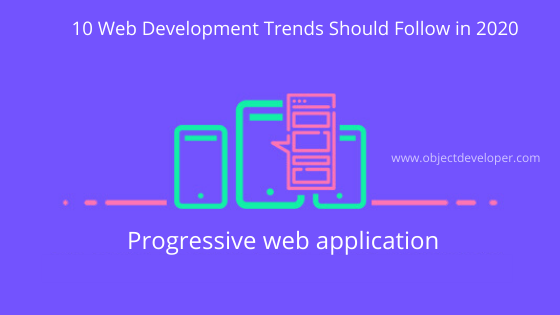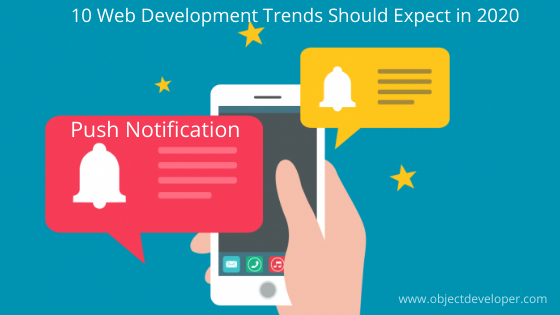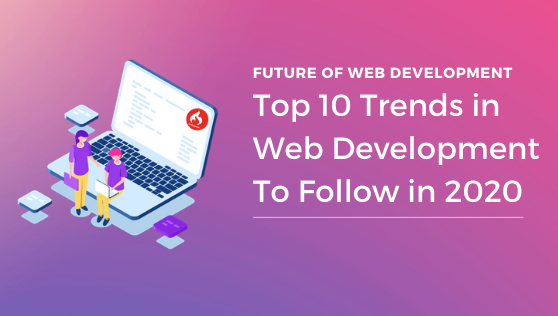Future of Web Development: Latest Top 10 Trends in Web Development To Follow in 2020

Best Web Design Company in Chittorgarh, Best Web Development Company in Chittorgarh
February 15, 2020
Inventory Management Software Development with Object Developer
August 11, 202010 Web Development Trends Should Expect in 2020
In a Hurry, Top 10 Web Development Trends to Follow in 2020:
If you’re like 63% of medium-sized businesses, you’re planning to upgrade your website to be faster, stronger, and more relevant. But before you do, pay attention to the web development trends and technologies creeping up in 2020.
Here are the latest web development trends that must be a part of your web development campaign and must be implemented in 2020.
1. Chatbots, AI, and Machine Learning
This must be the first trend in web development you should be focusing always. Providing a better user experience is the intended target of every website owner. Answering the user’s question and helping them in their task is equally necessary. In many cases, organizations hire humans to provide 24*7 support to their users. In most of the cases, these compliments with the help of AI and Machine Learning. This can be used to make chatbots that can guide your visitors and provide them with instant support.

The communication with chatbots has been increasing day by day and has reached out to various platforms like social media websites, e-commerce websites, apps, and many more such platforms. With the passing year, AI and machine learning have been able to become smart and can now solve even complex problems. It can also provide better customer service to the users and also make it efficient. It guides your users to complete a transaction, answer their queries, and redirect them to the appropriate portions of the website.
Some platforms like Facebook, Twitter, Google, etc. have invested heavily in the chatbots, AI, and Machine Learning and is expected to make significant changes in the web development industry. Facebook, Amazon, Netflix and other such websites are already using these web development technologies.
2. Virtual Reality and Augmented Reality
The rapid growth in internet speed access to the public has helped the users to consume content, where videos turn out to be a significant form of data consumption. Earlier, the technologies of 360 videos, 360 images, virtual reality videos, and interactive videos also came into being. Currently, it has not been able to become quite popular as it is a bit costly to design the video and implement it on the website. This can also help you to provide a better experience for the users, and even get better sales. Although, these have not become mainstream in the e-commerce websites, but can be tried in the video hosting services.

Many websites like Google, YouTube, Microsoft, etc. have been implementing it into their websites. Nowadays, you can watch interactive videos and YouTube videos on VR. This technology in web development, in the not so far future, will become a mainstream form of video communication.
3. Motion UI
The internet is massive. But you know that. What you might not know, though, is how that affects the average person’s attention span; some sources claim that the human attention span is worse than that of a goldfish.

And what better way to grab the attention of a user than with a captivating motion UI?
The Atlantic uses this on their Population Healthier page. As you scroll down the page, it changes and adapts to keep the visitor engaged.
Since attention spans are suffering, you’ll likely see more motion UI efforts on the part of developers to grab visitor attention and keep them engaged. Of course, we have yet to see how effective this strategy is. It might turn out to be a dud. But we won’t know until closer to 2020 or 2021.
4. Voice Search
From 2007 to 2018, voice search queries multiplied by 40 times. And today, 35% of people use Siri at least once per day, and 59% of teens and 35% of adults use voice search on a daily. By 2020, 75% of search queries will be done with voice instead of text.
The point?
Voice search is a trend breaking into search engines everywhere. And technology like Siri on iPhone, Cortana on Android, Google Assistant from Google, and Alexa and Echo from Amazon aren’t only increasing how commonplace voice search is, it’s making consumers more comfortable with the feature.
two out of five people say voice-activated devices are essential to their lives.

First, it enhances the importance of making your website mobile responsive. 20% of mobile searches are voice searches, according to Google.
Second, as consumers become increasingly comfortable (and used to) using voice search to browse the internet, you might eventually want to integrate voice search internally on your website.
Fortunately, you can easily add a voice search recognition API to your website. And two of the world’s largest web browsers — Google Chrome and Firefox — support the technology. This means that users don’t have to voice search to find your website and then text search on your website itself.
They can search for what they want on your domain, but, more importantly, they can search in the way they want (Side note: here’s how you can optimize your website for voice searches).
5. Internet of Things
Here comes another latest web development trend you should be taken seriously. Internet of Things (IoT) is the set of devices that are connected to the internet and help to provide better services to the people. In the dream to create smart homes, many IoT devices are used like smart light bulbs, smart cameras, etc.
It enhances the efficiency and accuracy of the gadget. These can be connected to the internet and can be used to create an enjoyable experience. These websites can help you to interact with your smart devices with ease. Even though there are only a few websites and IoT devices as for today, it is expected to grow forward shortly. Its complexity is expected to increase, and its reach is also likely to reach deeper into our lives.

6. Progressive Web Application
New trends in web development also feature mobile apps. Nowadays mobile devices drive a significant portion of web traffic with a share of more than 50% web traffic. The apps contribute the most to drive traffic as it is easier and faster to access websites. The mobile apps account for 89% of the total mobile time.
Considering this, progressive web apps are developed. Progressive web apps are web applications that are quite similar to the mobile application but are web pages or websites in nature.

These have the advantage of both web browsers and apps and also provide a better user experience to the users. The benefits of apps like the ability to work offline, fast loading times, reliability, and push notifications are some of the benefits provided by these web apps. Unlike usual apps, these require less time to develop and can be easily maintained.
Mobile apps have an over-saturated market and hence are losing their appeal. The PWAs, in turn, can prove out to be an excellent alternative.
7. API-First Design
The more connected our world becomes the more APIs that each application ends up having. And with the rise of the IoT, our mobile devices, homes, cars, gaming systems, wearable tech, and laptops are all connected.
That offers a lot of convenience for the user. But all of those connections can get a bit dicey if the developer starts building the application in the wrong place. Traditionally, developers start with the user and build from there. They design the application and add in the appropriate APIs after the fact.
The back-end team starts working on an API, and once it’s finished, they give the API to the front-end team for testing. At the same time, the front-end team works to build SDKs to test and double-check the API’s interactions.

There’s a problem, though. This means that front-end developers are waiting on back-end developers and the process often takes an inordinate amount of time and coordination.
With API-first design, however, developers start with the appropriate APIs and then “build the product on top of it”:
If you want to get things done faster and without making front-end developers wait on back-end developers at every step of the way, a platform with headless content management capabilities - also known as an API-first solution - would be the way forward.
8. Responsive Web Design
Responsive Web design is becoming a must-have rather than a nice-to-have. In 2015, 35% of website traffic was served to mobile devices. Then, in 2016, that number was 43%. Now, in 2017, 50.3% of website traffic happened on a phone instead of a computer or tablet. That’s an increase in mobile traffic by 45% just from 2015 to 2018.
With all of that, then, it isn’t surprising that Google is going to release its mobile-first indexing during or after 2019 arrives officially.
But what is mobile-first indexing?
It’s simple. Here’s how Search Engine Watch explains it:
“Currently, Google looks at the desktop version of a site and then bases how it will rank the mobile site according to that information. Once this update rolls out, the opposite of what will happen. Google will begin looking at your mobile site and from that, will rank the desktop site.”

In other words, mobile websites will officially become the end-all of your rankings. So, how can developers prepare for this upcoming change? Well, many of you probably already are - if you have a mobile responsive website, you’re in the clear.
In the words of a Google representative…
“If you have a responsive site or a dynamic serving site where the primary content and markup is equivalent across mobile and desktop, you shouldn’t have to change anything.”
9. Push Notification

New web development trends feature speech recognition also. Voice search is quite popular nowadays as it has now become accessible on mobile, PCs, and many other platforms as well. Nowadays, there are numerous voice assistants like Siri, Cortana, Google Now, Alexa, and many other third-party apps as well. Hence it becomes necessary that you cash out this technology, else you will lose a significant portion of your users.
Nowadays voice user interfaces can understand and act on complex voice commands as well.
Voice user interface coupled with machine learning can predict your user needs and provide them with the results. Hence it becomes necessary that your website content is conversational and answers the user’s questions
10. security

Security of the website is quite essential as there are a large number of attacks that have been taking place.
Various web browsers warn the users about any lousy site. Apart from these, the secure websites get a better ranking on search engines as compared to the insecure ones.





